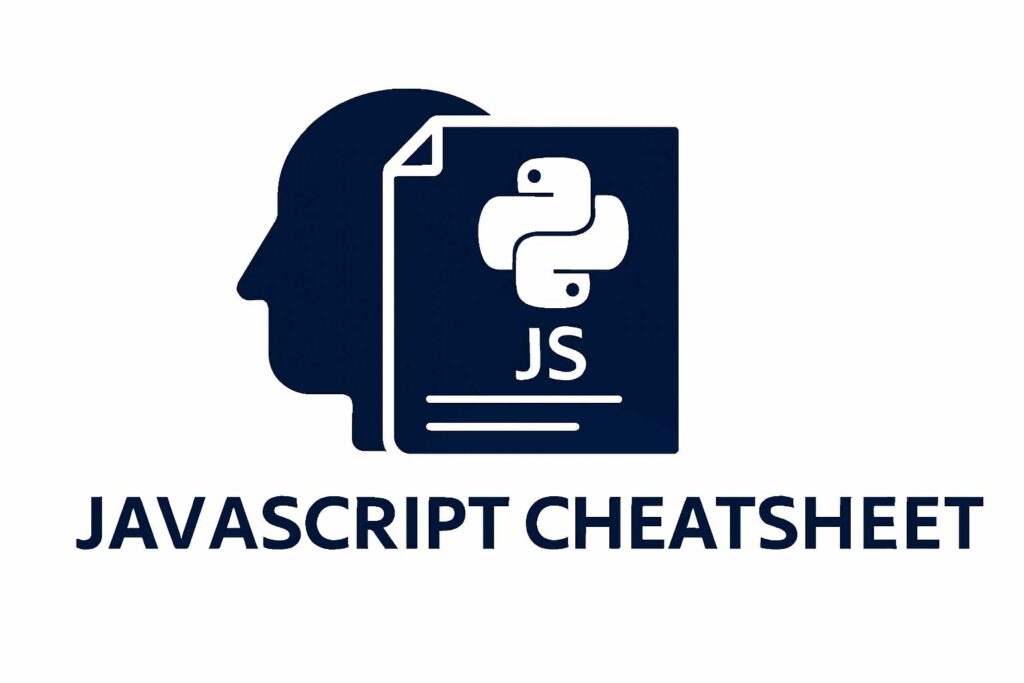Table of Contents:
JavaScript Cheat Sheet — Complete Syntax Reference & Examples
JavaScript is the core scripting language of the web, enabling interactivity, dynamic content updates, and real-time functionality in modern web applications.
This JavaScript Cheat Sheet provides a quick reference to all the fundamental syntax, built-in functions, and ES6 features every developer should know.
Introduction to JavaScript
JavaScript (JS) is a client-side scripting language that runs in browsers. It can manipulate HTML, CSS, and handle user events, making web pages interactive.
Example:
<!DOCTYPE html>
<html>
<body>
<script>
document.write("Hello, JavaScript World!");
</script>
</body>
</html>
JavaScript Variables and Data Types
JavaScript supports three ways to declare variables:
var(function-scoped, old)let(block-scoped, modern)const(block-scoped, constant)
Example:
let name = "John";
const age = 25;
var city = "New York";
| Data Type | Example | Description |
|---|---|---|
| String | "Hello" | Text data |
| Number | 25, 3.14 | Integer or float |
| Boolean | true, false | Logical values |
| Array | [1, 2, 3] | Ordered list |
| Object | {name:"John", age:30} | Key-value pair |
| Undefined | let x; | No assigned value |
| Null | let x = null; | Empty or unknown |
| Symbol | Symbol("id") | Unique identifiers |
JavaScript Operators
| Type | Operators | Example | Description |
|---|---|---|---|
| Arithmetic | + - * / % ** | x + y | Math operations |
| Assignment | = += -= *= /= | x += 5 | Assign values |
| Comparison | == === != !== > < | x == y | Compare values |
| Logical | `&& | !` | |
| Ternary | ? : | x > y ? x : y | Conditional operator |
| String | + | "Hello " + "World" | Concatenation |
JavaScript Conditional Statements
let marks = 85;
if (marks >= 90) {
console.log("Excellent!");
} else if (marks >= 75) {
console.log("Good!");
} else {
console.log("Try again.");
}
Switch Statement:
let day = "Monday";
switch(day) {
case "Monday":
console.log("Start of the week");
break;
case "Friday":
console.log("Weekend ahead!");
break;
default:
console.log("Midweek mode");
}
JavaScript Loops and Iterations
| Loop Type | Syntax Example | Description |
|---|---|---|
| For Loop | for(let i=0; i<5; i++) | Repeats a block of code |
| While Loop | while(i < 5) | Runs while condition true |
| Do…While | do { } while(i < 5) | Executes once before checking condition |
| For…of | for(let x of arr) | Iterates through iterable objects |
| For…in | for(let key in obj) | Iterates through object properties |
Example:
let fruits = ["Apple", "Banana", "Cherry"];
for (let fruit of fruits) {
console.log(fruit);
}
JavaScript Functions
Functions are blocks of reusable code.
Function Declaration:
function greet(name) {
return `Hello, ${name}`;
}
console.log(greet("Alice"));
Arrow Function (ES6):
const add = (a, b) => a + b;
console.log(add(5, 3));
Default Parameters:
function welcome(name = "Guest") {
return `Welcome, ${name}!`;
}
JavaScript Arrays
let colors = ["Red", "Green", "Blue"];
colors.push("Yellow");
colors.pop();
console.log(colors);
| Method | Example | Description |
|---|---|---|
push() | arr.push("item") | Add element to end |
pop() | arr.pop() | Remove last element |
shift() | arr.shift() | Remove first element |
unshift() | arr.unshift("item") | Add to beginning |
sort() | arr.sort() | Sort alphabetically |
reverse() | arr.reverse() | Reverse order |
map() | arr.map(fn) | Apply function to all items |
filter() | arr.filter(fn) | Filter items |
reduce() | arr.reduce(fn) | Accumulate values |
JavaScript Objects
Objects store key-value pairs.
let user = {
name: "John",
age: 25,
greet: function() {
return "Hello " + this.name;
}
};
console.log(user.greet());
Accessing Properties
console.log(user.name);
console.log(user["age"]);
JavaScript Strings
| Method | Example | Description |
|---|---|---|
length | str.length | String length |
toUpperCase() | str.toUpperCase() | Convert to uppercase |
toLowerCase() | str.toLowerCase() | Convert to lowercase |
trim() | str.trim() | Remove whitespace |
substring() | str.substring(1,4) | Extract part of string |
replace() | str.replace("old", "new") | Replace text |
split() | str.split(",") | Split into array |
javascript cheat sheet, javascript syntax guide, js examples for beginners, javascript es6 reference, javascript loops and arrays, javascript dom methods, javascript functions list, javascript coding basics, javascript string methods, js event handling
JavaScript DOM Manipulation
The Document Object Model (DOM) connects JS with HTML/CSS, allowing real-time page updates.
<p id="demo">Hello!</p>
<script>
document.getElementById("demo").innerHTML = "Welcome to JS!";
document.querySelector("#demo").style.color = "blue";
</script>
| DOM Method | Description |
|---|---|
getElementById() | Selects element by ID |
getElementsByClassName() | Selects elements by class |
querySelector() | Selects first matching element |
createElement() | Creates new HTML element |
appendChild() | Adds element to DOM |
removeChild() | Removes element |
JavaScript Events
| Event | Description |
|---|---|
onclick | Triggered on click |
onmouseover | On mouse hover |
onkeydown | When key pressed |
onload | When page loads |
Example:
<button onclick="alert('Button Clicked!')">Click Me</button>
JavaScript ES6 Features
| Feature | Syntax | Example |
|---|---|---|
| Template Literals | `Hello ${name}` | ${} interpolation |
| Destructuring | let {a,b} = obj | Extract values |
| Spread Operator | arr2 = [...arr1] | Copy/merge arrays |
| Classes | class Car {} | OOP structure |
| Promises | new Promise() | Handle async code |
| Arrow Functions | (a,b)=>a+b | Short syntax |
Example: DOM + Event Handling
<button id="btn">Click Me</button>
<p id="output"></p>
<script>
document.getElementById("btn").addEventListener("click", function() {
document.getElementById("output").innerHTML = "Button was clicked!";
});
</script>
Related Internal Resources
FAQ – JavaScript Cheat Sheet
Q1: What is JavaScript mainly used for?
JavaScript is used for creating dynamic web pages, validating forms, handling events, and building web apps.
Q2: What’s the difference between let, var, and const?let and const are block-scoped (modern), while var is function-scoped (legacy).
Q3: Can JavaScript run without a browser?
Yes, using environments like Node.js, JS can run outside the browser.
Q4: How do I debug JavaScript?
Use console.log() or browser Developer Tools.
Q5: What is ES6?
ES6 (ECMAScript 2015) introduced modern JS features like arrow functions, classes, promises, and destructuring.



